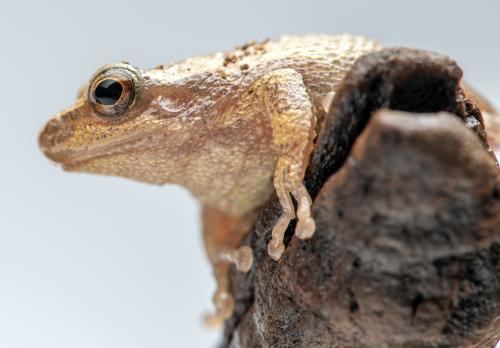
Scientific name: Pseudacris crucifer
Mi’kmaq Translation: Jijawej
French Translation: Rainette Crucifere
Gaelic Translation: Bìdean Earrach (no Losgann-Earrach, no peeper an earraich)
Physical Description
Spring Peepers are a thumbnail sized tree frog. They are tan, grey, or rusty brown to dark brown. There is a dark X-shaped mark on the back, along with a V-shaped mark on the head between the eyes. The belly is white, and the inner thighs are a light to dark yellow. While they lack webbing between their toes, their toes do have sticky pads for climbing. Newly hatched tadpoles (larvae) are legless with long tails. Their bodies are tan and brown with dark spots. As the tadpoles grow, they develop brass coloured flecks on their body. The Spring Peeper call sounds like a high-pitched “peep”, which is repeated continually. You will likely hear hundreds before you ever see one.
Size
Newly developed young range from 1.3 to 1.4cm in length
Adult males range from 2.0 to 3.3cm in length
Adult females range from 2.7 to 3.7cm in length
Range and Distribution
Spring Peepers can be found from northwestern Manitoba east to the Atlantic Provinces. In Nova Scotia, they are common in all regions of the Province.
Habitat
During the breeding season, Peepers use fish-free, temporary water bodies like marshes, bogs and ponds. Outside of breeding season, they are common in woodland areas within a few hundred meters of their breeding sites. Hibernation preferably happens below the frost line in mammal burrows and in the cavities of tree roots. They may also overwinter under logs or buried in leaf litter.
Diet
Spring Peepers feed on a variety of soft-bodied invertebrates. This includes small spiders, moth larvae, water midges, snails and slugs.
Reproduction and Life Cycle
Spring Peepers emerge from hibernation in the spring. They are active between March and October. Breeding season happens from April to June, and a process called amplexus is used. This is when the male uses his front leg to grab the females' body, causing her to release the eggs, which are fertilized externally. During the breeding season, the throat of the adult males is black or dark brown, spotted with light yellow. Females will lay up to 1500 brown and white eggs, either singly or in small clusters. The egg mass is attached to twigs and leaf litter towards to the bottom of the water body. Egg development is quick. Depending on water temperature, they will hatch in one to three weeks. Tadpoles (larvae) develop into adults after three months. Sexual maturity is reached in the first year to two years after they are fully developed. Their average life span is three to four years. Spring Peepers can survive cold temperatures while hibernating by increasing the amount of glucose in their blood. This acts as a “cryoprotectant”, which means the water is unable to freeze inside the blood cells.
Status
NSESA: No status
COSEWIC: Not assessed
Threats
Their populations are believed to be stable. The loss of breeding ponds, along with wetland and shoreline habitats do pose significant threats to Spring Peepers. Other factors like climate change, pollution, road mortality, and the use of the herbicides and pesticides also pose long-term health risks for these frogs.